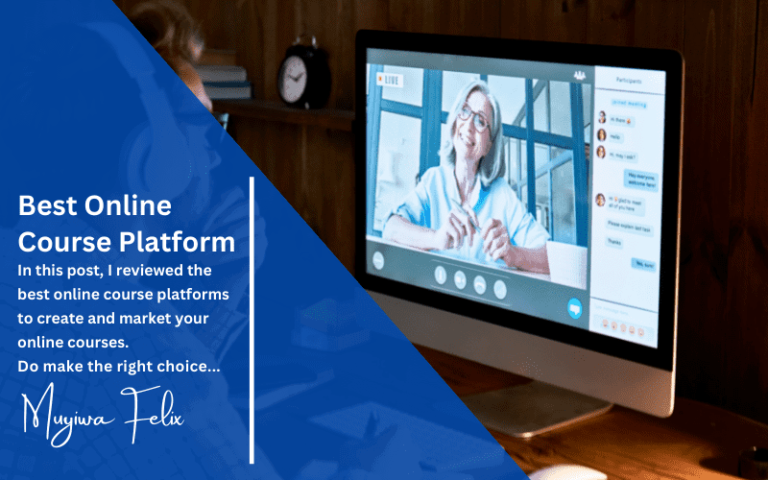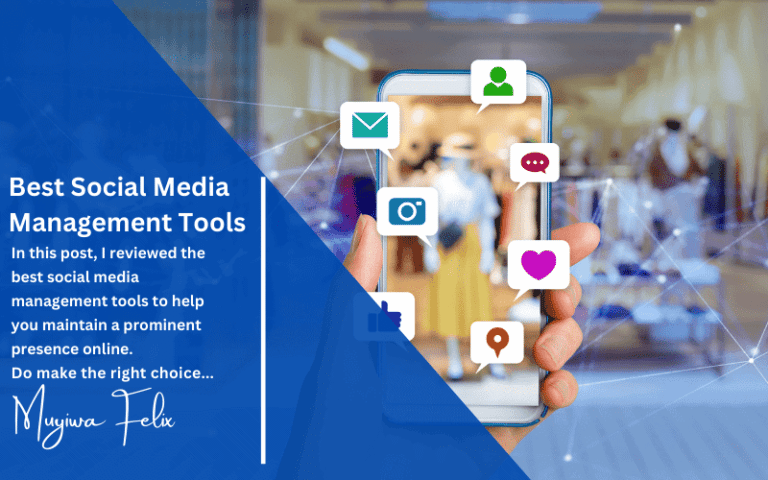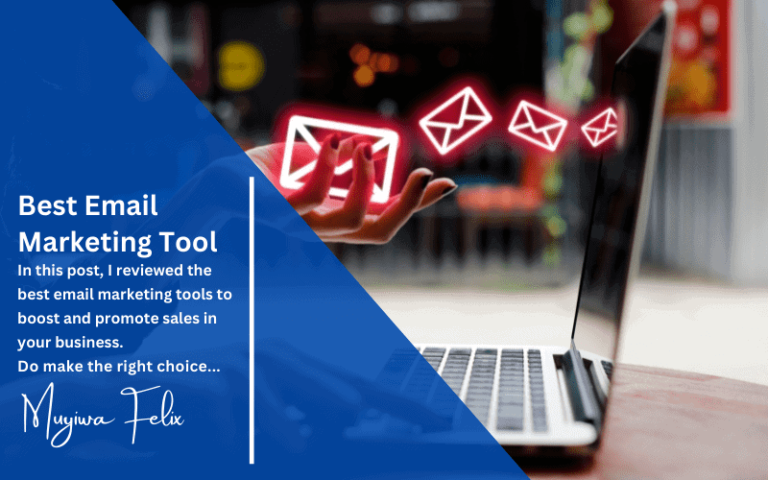10+ Best Podcasting Software to Record and Edit your Shows in 2024
Making the right choice of podcasting software to use is highly important to the success of your business. You need a podcast that can help you easily navigate the process of recording, editing, and publishing your podcast in the best quality form in order to meet your goals. In this post, I have ranked the best podcast software for recording and editing your show like a pro.

As per the statistics, 51% of the United States people listen to podcasts, and 31% tune in every month. These are good numbers, right? So how do you entice these people to subscribe to your podcast channel? It’s through choosing the right content and ensuring the high quality of your podcast audios or videos.
The choice of good podcast software is essential for your podcasts. It will determine the quality of your podcast content, audio, or videos. This software will help you record, add effects, edit, interact with people you may need to include in the podcast, and host your podcast. No one wants to listen to noisy podcasts that are not clear in this 21st century full of reliable podcast software.
However, choosing podcast software for recording and editing your shows for the first time can be a daunting task. This is why we have taken much time to analyze some of the best 10 podcast software for you. We want to ensure that you attract as many audiences as possible by incorporating the best software in your podcasting. This article has all the information you need to choose reliable podcast software.
What Do You Need to Start a Podcast?
Here are the tools you need to start a podcast;
1. Podcast Microphone
This is the main equipment you will need to record your podcast to ensure it’s clear. When choosing a microphone, you must consider your podcasting environment and the kind of connection cable required. Quality and budget must be other considerations you need to look at.
My top Podcast Microphone recommendations are
- Samson q2u
- Blue Yeti Microphones
- Samson q9u
2. Camera
If your podcast is only audio, you don’t need a camera; however, if you are recording videos, you must buy a camera. You should consider the quality of the video you produce, so ensure you buy a camera that can record HD.
My top podcast camera recommendations are
- Sony Alpha 6300
- Canon m50
3. Headphones
Headphones are needed for clear recordings. To ensure you get rid of the background noise and improves your hearing. Make sure the headphones are quality and will serve your purpose.
4. Recording Software
This is another essential tool you need in podcast recording. The software gives you various features that can help you edit your audio or video, share, and schedule your content for future publication, etc. Make the right choice of software to help you achieve your podcasting goals.
Factors to Consider When Choosing Podcasting Software
Compatibility. You need to know your audience first for you to know the devices they use and whether they will be able to access your podcast through their devices.
Price: The amount you are ready to spend on recording the podcast must also be considered. The good thing is that there are several free software available. However, paid software offers more features.
Support team: You need a support team that you can rely on so that they will come to your aid when you have any issues with your software.
Ease of use: You don’t have to struggle to record your podcast; you need to get a software that is easy to use.
Software Features: Every software has special and unique recording software. Whether you are recording audio or a video, you need software with the best features to help create a quality podcast for your listeners.
What are the Steps to Recording a Podcast?
If you are a beginner, you might be wondering where to start when recording your podcast. Here is the step-by-step procedure.
1. Identify a topic
Give your podcast an enticing topic. You should choose a topic that represents your content and is easily searchable. In other words, your topic has to be search engine optimization (SEO) friendly so it can be found when people search for it.
2. Know your audience
You should have the people you are targeting to listen to your podcast in mind. Define the persona of your ideal listener. You can demystify this stage by using the following factors –
- Age bracket – Define the age bracket of your target audience
- Location – What location will your ideal audience be listening from?
- Interest – What issues/topics/lifestyles are most appealing to your ideal listener?
- Income range – What is the likely income range of your ideal listener? Understanding this will help you down the line when you want to monetize your podcast
- Other factors – this may include race, religion, political inclination, sport, etc.
While you may not be able to accurately decipher this information in the beginning, it will give you a basis to finetune your process in your podcasting journey.
3. Select a Podcasting Format
Will you host the podcast alone, with a guest, guest, or co-host? You have to also decide the format of podcast delivery. Popular formats include
Interview format – This podcasting format involves inviting a guest to the show to share their knowledge on a topic they are good at, an experience that is unique to them, or something peculiar to them. It can be done remotely or with both persons in the same location. For this podcasting method, you may need a setup of more than one microphone, a recording and editing software that can help you record remotely. Check out this list of podcasting software suitable for recording remotely
Tutorial Format – In this podcasting format, the anchor or guest teaches the listeners how to do things. This type of podcast will be suitable for listeners who want to learn new skills or improve their knowledge of a subject matter
Topical Format – This involves focusing your show/discussion on a particular topic while you explore different branches of the topic. You may have to invite new guests to share their unique insights on the topical issues you raise.
Narrative format – This format of podcasting is more about storytelling. A typical listener of a podcast with a narrative format wants to be held spellbound by the show delivery. The production of shows like this is often high-end with sound effects, music, and presentation that can keep the listeners entertained.
Make sure you choose a format you are comfortable with, suits your style, and with a setup that agrees with your budget.
4. Get your gear
Your gears include your microphone, boom stand, camera, and your recording, editing, and publishing software. This choice will help you optimize your podcast quality. Whether it’s audio or video, you need to check its quality.
5. Produce your first show
There is no perfect time to start. You just have to start. Start putting in the reps. Your first few episodes wont be the best but over time, you will definitely get better. The world is waiting to listen to you. Do it! Start!!
The Best Podcasting Software to Record and Edit Your Shows
Based on the podcasting format you choose, you may want to conduct an interview remotely or in person.
Here is my top list of Podcasting software to remotely record and edit your interview shows with guests
1. Riverside.fm

With this software, you can record 4K videos and uncompressed 48 kHz audio, giving the high-quality recording. You can record remotely with this software and invite a maximum of 7 guests to your recording regardless of their location. Recording your podcast with Riverside.fm gives your recording clarity, ensuring your podcast is free from background noise.
It has automated recording tools such as a magic editor, clip, etc. Through these tools, you can create your podcast and divide it into short clips that you can share. In addition, you can record separate clips from your guests and edit them independently with advanced software. Riverside has additional features like podcast transcription, live streaming, and Shopify.
Riverside.fm Pricing

Riverside.fm has a free plan. When billed annually, the pricing goes thus
- Standard option – $15 per month
- Pro plan – $24 per month
- Enterprise – on request
Compatibility
Its browser-based software can be accessible through Mac, Windows desktops, iOS, iPad and Android.
Key Features
- Producer mode
- Screen sharing features
- Live calls and streaming
- WAV or MP3 audio recording of 16-bit 48 kHz
- Clip creator and magic editor tools
- A Media board that helps add sound effects
Pros
- It’s a high-quality recording tool.
- Has post-production control with different tracks.
- It can contain up to 7 participants.
Cons
Doesn’t have advanced editing features.
2. Squadcast.fm
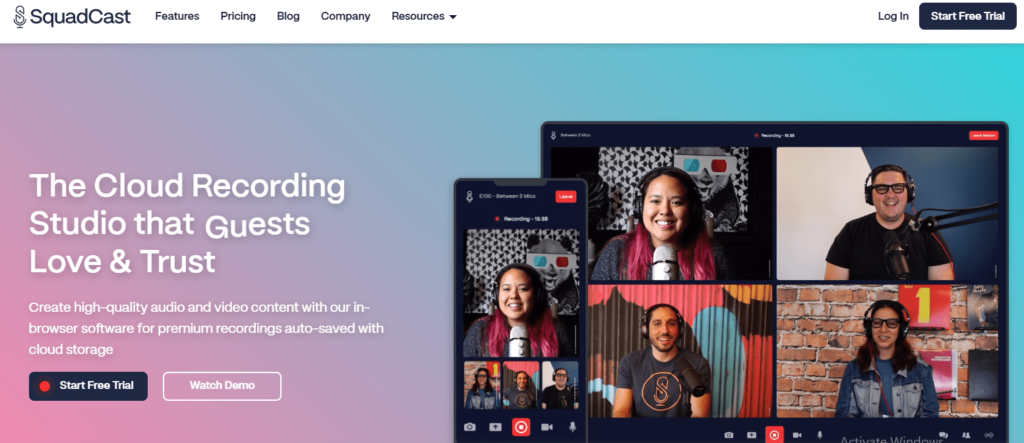
Squadcast.Fm is my second pick for the best podcasting software for recording and editing. It is capable of recording both video and audio components of your podcast depending on what you want. The lower plan permits a maximum of 4 participants, while the higher-tier option is up to 10 guests.
In addition, it has a signature feature that allows progressive recording and auto-saves recording to ensure no loss of content. The platform is intuitive and makes it easy to edit every content your produce. You can record your content on your local device while you also enjoy a cloud backup if your file is inaccessible on your local device.
Squadcast.fm Pricing

Squadcast.fm offers at least 7days free for customers to check out the features of the software. The monthly/annual plans go thus:
- Indie – $20 per month
- Pro – $40 per month
- Studio – $80 per month
- Enterprise – Contact the sales team
Compatibility
It’s a browser-based podcast recorder accessible through windows and mac operating systems.
Key Features
- Separate recording audio and video files – Access separately recorded audio and video content that can be seamlessly synced together in post-production
- Progressive uploads and Automatic Cloud backup – Confidently hit the record button, knowing all audio and video content is continuously auto-saved, backed up, and stored in the cloud
- High-quality remote recording – Enjoy industry-standard remote recording in 1080p
Pros
- Ensures no content is lost because of the auto-saving feature
- It’s simple to use
- Reliable support system
Cons
- It’s expensive
- It can’t use a mobile phone to record
- No live streaming
- No in-app recording tools
3. Ringr
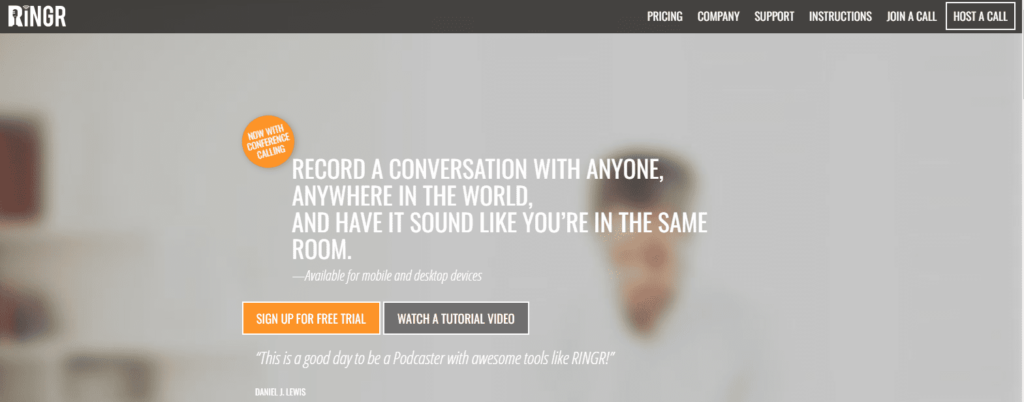
Ringr is my third pick for podcasting software suitable for recording and editing interviews remotely. Ringr only records audio. It does not record video. The software helps record conversations from different people regardless of location and automatically merges them as though the people talking are in the same room. It is one of the best remote recording software on the market but with fewer editing tools.
Ringr Pricing
Free trial for 7 days
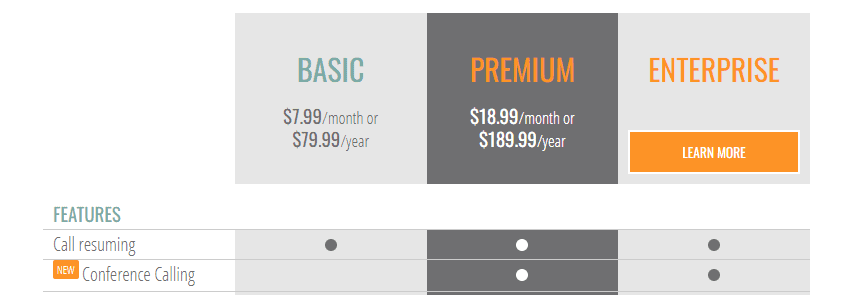
- Basic – $7.99/month or $79.99/year
- Premium – $18.99/month or $189.99/year
Compatibility
Available for mobile and desktop devices
Key Features
- Conferencing tools for more than 4 guests
- Split track recording
- Enterprise dashboard available for enterprise option
Pros
- Has more storage space
- Available on widely used devices like mobile phones
Cons
- The basic plan allows a short recording or 22 kHz
- Has editing issues
4. Zencastr

Zencastr is a relatively new app in the podcasting space and the team behind really mean business. It’s a remote recording software like Ringr and offers quality recording services. The browser-based software records audio in WAV or MP3 files, and the video is up to 4k depending on the plan you choose.
Zencastr is also an all-in-one platform where you can record, edit, publish and monitor your progress. You can conveniently host up to 11 guests in top video and audio quality. Also, when you use Zencastr, you can enjoy cloud backup of your recordings
Zencastr Pricing

Zencastr has a free option with limited features. When paid annually, the plans go thus
- Professional – $18/month
- Growth – $45/month
Compatibility
Accessible through Mac and window devices
Key Features
- Has editing tools to give better audio like noise and hum reduction tools
- Cloud storage software
- Video recording of up to 1080D
- Editing features
Pros
- Has automated editing tools that will save you time and enhance recording quality
- Records both video and audio
Cons
- Video recording is in beta
- Holds a maximum of 4 participants
Having mentioned the podcast software suitable for remotely recording and editing your interview format shows, here is my top list of Podcasting software to record your shows in person
1. Audacity
Audacity tops my list of the best podcasting for recording and editing your shows when it’s just one person (you) presenting it. It is a free, open-source software that allows users to record their podcasts on desktop devices. It has editing tools such as noise cancellation, trimming and cutting, and audio equalization. Audacity doesn’t support video recording.
Audacity Pricing
Audacity is completely free
Compatibility
Available on windows and Mac devices
Key features
- Open source software
- Multi-track audio editor
- VST3 support real-time effects
- Records up to 32-bit, 44.1 kHz
Pros
- There are no charges
- Has good editing tools
Cons
- It doesn’t support video recording
- No live call or email support
- No remote recording features
2. Adobe Audition

It’s an editing and recording podcast software for creating audio and video content. Some of its features include; multitrack, waveform, and spectral display, which are good for editing, mixing, restoring, and creating audio podcast content. It’s a high-quality recording tool, but you can record directly to your device hence can’t support remote recording with guests.
Adobe Audition Pricing
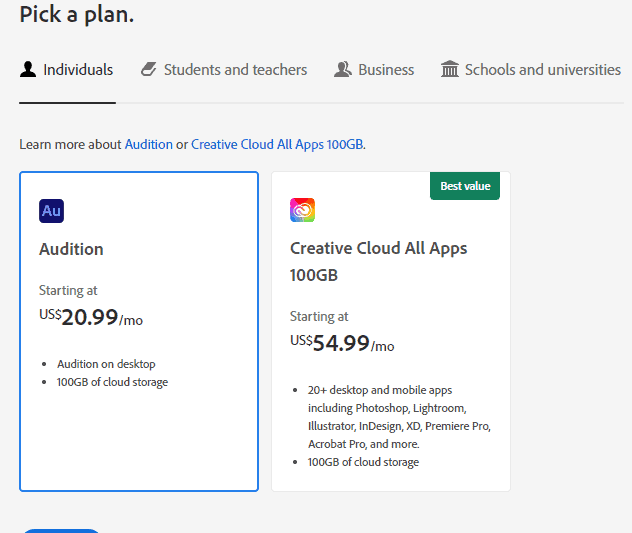
You can enjoy the features of Adobe Audition for 7 days free before deciding to pay. The standalone application goes for $20.99 per month. Together in a creative suite that has 20+ Adobe applications, you pay $54.99 per month for the Individual plan.
Compatibility
- Downloadable on mac and windows desktops.
Key Features
- Editing, mixing, recording, and audio restore tools.
- Sound effects
- Multitrack recording
- Essential sound panel
Pros
- Easy combination with premiere pro
- Saves time through the use of recording templates
- Has advanced editing features for a quality audio
- Has a free trial.
Cons
- Not easy to use for a beginner
3. Garageband
It’s a free option for Apple users meant for editing audio with simple audio editing and recording features. It allows for easy addition of effects, equalizing and compressing of audio. In addition, it’s used for creating music.
Garageband Pricing
Garageband is free
Compatibility
It’s only compatible with Mac and iOS devices.
Key features
- Sampling
- Editing and recording features
- Plug-ins
Pros
- You won’t pay anything to use this software
- It’s user-friendly
- Presence of audio effects.
Cons
It doesn’t allow remote recording
Garageband cannot render your podcast loudness in -19 (Mono files) and -16 LUFS (Stereo files)
4. Alitu
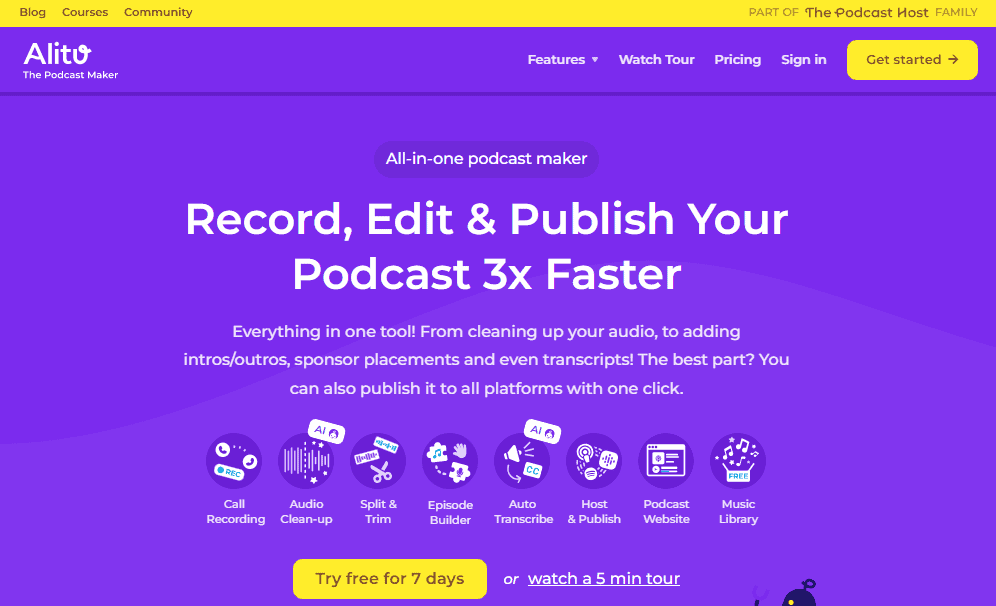
Alitu is an all-in-one platform where you can record, edit, add pre-saved intros and outros, auto-transcribe, and add music from a vast music library. Alitu makes all the stages of podcasting fun by bringing all the functionalities you need for success into one platform.
In addition, each of their subscription plans offers unlimited downloads and a one-click functionality to publish your new episodes on your favorite hosting platform like Spotify, apple podcast, google podcast etc.
Alitu Pricing
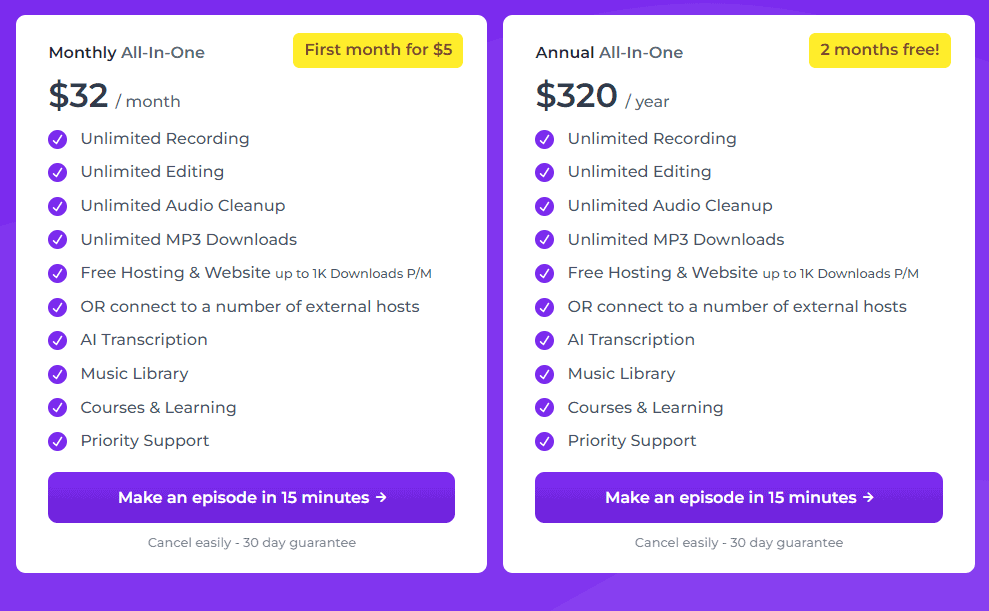
Alitu offers 7 days free trial. The paid plans are
- Monthly All-in-one – $32 per month
- Yearly All-in-one – $320 per month
Alitu Key Features
Dedicated website – Alitu gives you your own podcast website featuring every episode and links to your social channels.
Scheduling – Schedule your episodes to publish when it suits you
Alitu Player – Embed any episode on any website with Alitu Player so your readers can listen right from your website/blog
Analytics – Gain insight into the performance of your productions per episode; find out where your listeners are from, and what devices they listen on.
5. Apple Logic Pro X
It’s more advanced than Garageband and offers recording and editing tools. It’s also a music recording tool but has some features for podcast recording. Its additional features include; a noise equalizer and audio compression.
Apple Logic Pro X Pricing
It charges a one-time fee of $199.99 as opposed to the rest that charges monthly.
Compatibility
It can be used by Mac users only.
Key Features
- Smart controls features
- Automatic coloring tools
- Control tracks
- Score editor
- Control surfaces
Pros
- Produces high-quality recordings due to its high resolution and editing features.
- Score editor helps edit numerous tracks at a go.
Cons
More of a music recording software than podcast editing software; hence fewer tools for podcast editing
Final thoughts
Podcasting can be used for various reasons. It can be a way to market your business, entertain, host a show, etc. You need to impress your audience with your podcast, which is why you need to use the right podcasting tools or equipment to get the required quality.
Read my article on how to record a podcast. After recording, you need a podcast hosting platform. Read my post on the best podcast hosting platform.
In conclusion, podcasting is a fun thing to do. It is a proven way to cement your space in your chosen niche. Start today. Don’t overthink it. As long as you keep showing up and keep having fun, you will succeed.
Is there any software you think is omitted from this list? Do let me know in the comment section. I read all comments and respond to them personally.

Ogunjobi Oluwamuyiwa Felix preferred to be called Muyiwa Felix, is a personal finance coach and Insurance advisor. He creates content that addresses the core of personal finance in Canada, the United States, and the world at large. Daily, he meets up with clients who are interested in financial risk management, income protection, wealth-building, retirement planning, and tax-efficient investing strategies.


